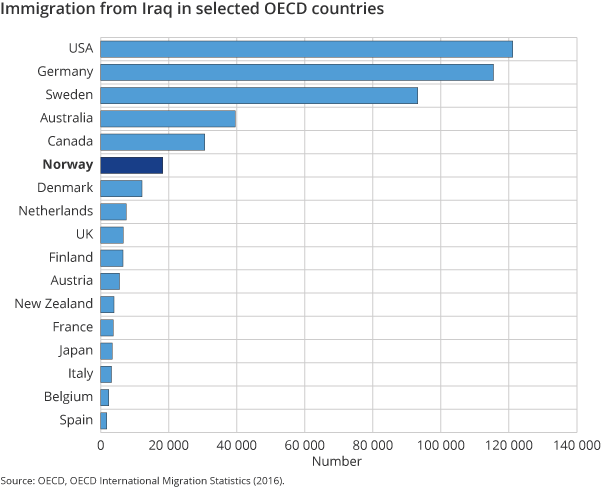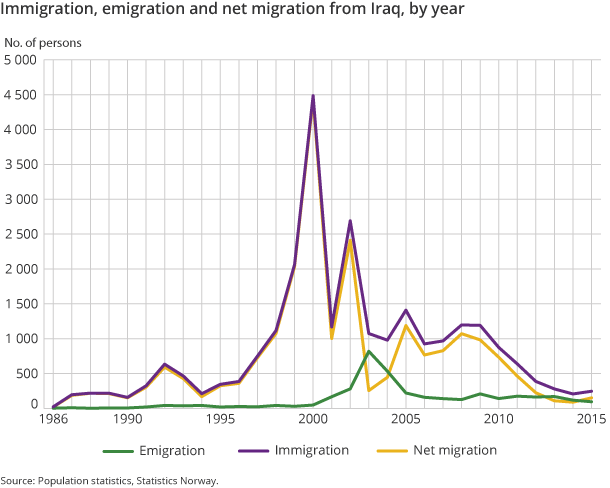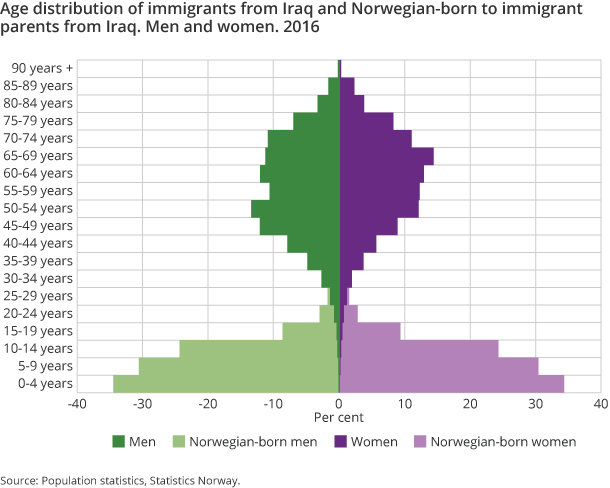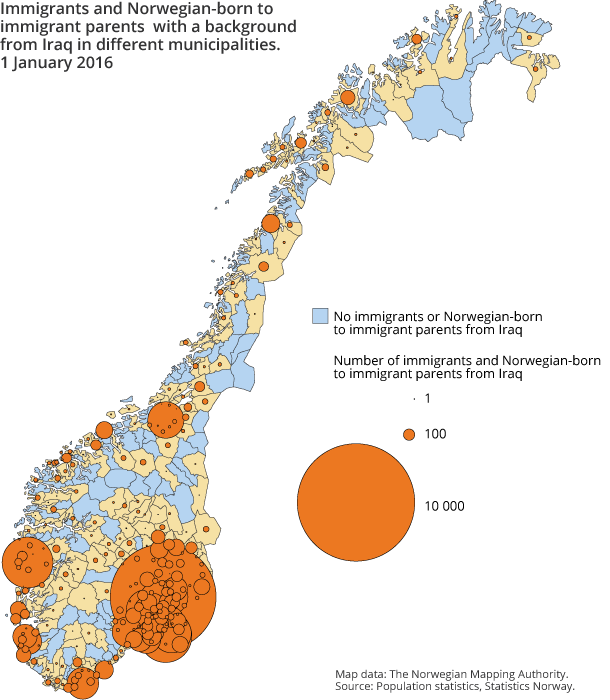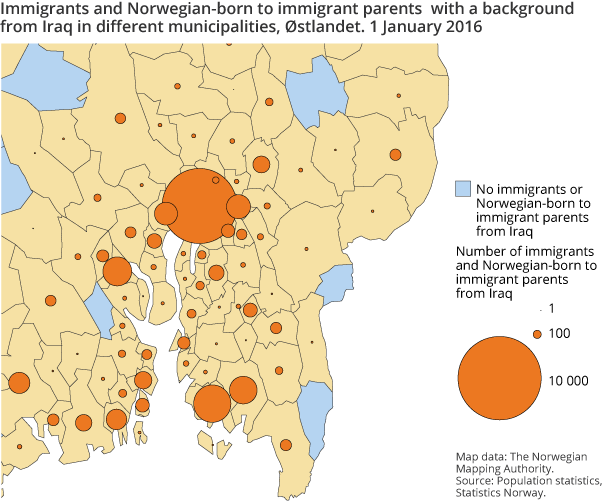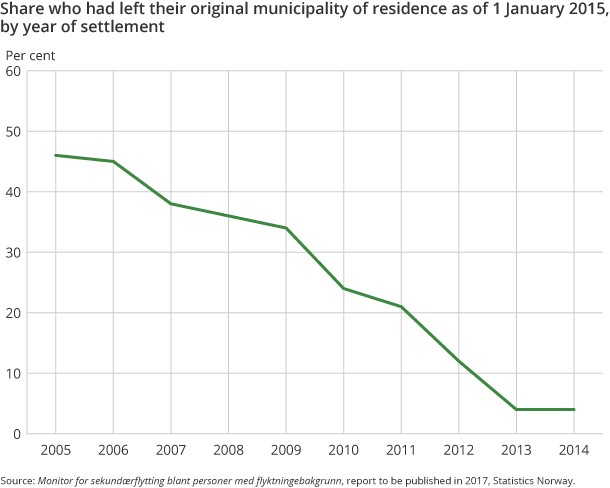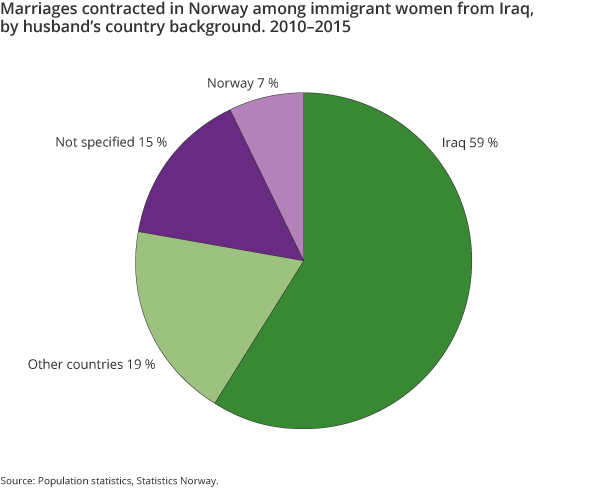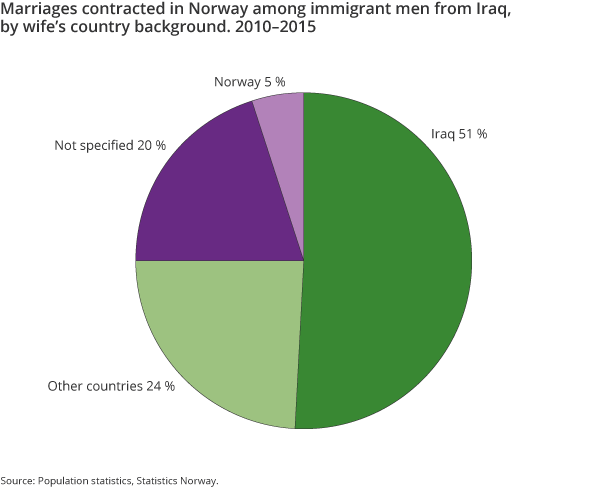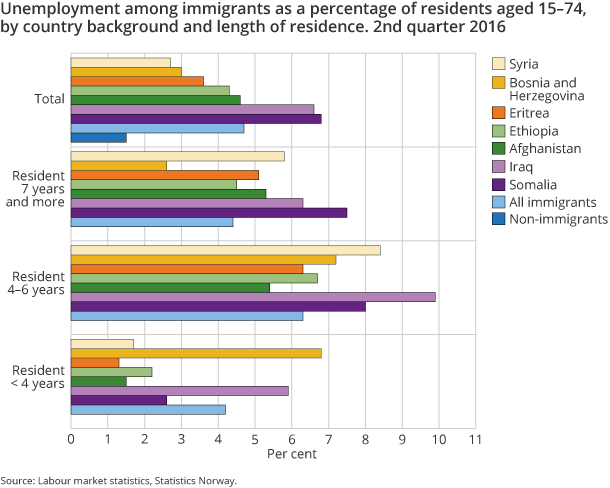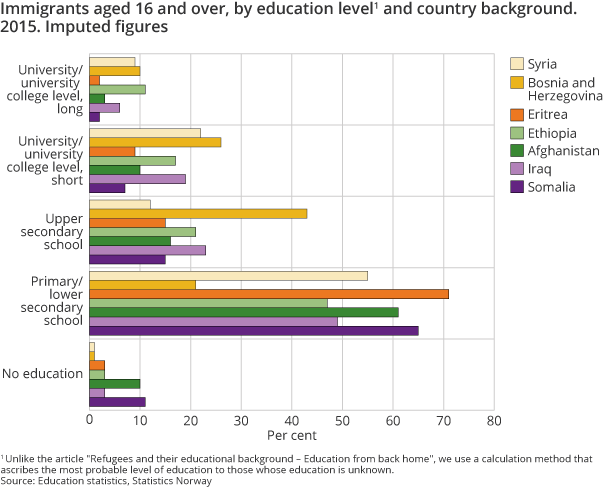Statistical analysis, 2017
Refugees from Iraq
Iraqis in Norway – a demographic portrait
Published:
This article was first published in Norwegian, in Statistics Norway’s journal Samfunnsspeilet: Ordemann, Adrian Haugen (2016): Flyktninger fra Irak. Irakere i Norge – et demografisk portrett. Samfunnsspeilet 4/2016. Statistisk sentralbyrå.
Despite considerable emigration from Norway, Iraqis currently represent the largest immigrant group with a refugee background after the Somalis, with over 22 000. Most live in Oslo and Østfold. Their education level is low, but is close to the average for refugees. Unemployment is high – higher than the level of education would suggest.
- Series archive
- Statistical analysis, 2017
The persecution of folk groups– particularly the Kurds and Shiites – as well as the Iraq war and the turbulence during its aftermath, drove many Iraqis out of their homeland. Some came to Norway, which accepted a large number per capita compared to other OECD countries. Among all 34 OECD countries, only five nations – the USA, Germany, Sweden, Australia and Canada – took in more Iraqis in the period 2000–2013 (see Figure 1). More Iraqis came to Norway than, for example, Italy, Spain, France, the Netherlands or the UK.
In 1987, the number who immigrated from Iraq to Norway within one year surpassed 100 for the first time ever, and it would be more than ten years before the number stabilised at a high level (see Figure 2). Many arrived in the years before and after the millennium year of 2000, culminating with 4 400 Iraqi immigrants. After a decline in 2003, a new wave arrived in 2005. This began to fall in 2009, the year when the total number of immigrants from Iraq surpassed 20 000.
The number of asylum seekers from Iraq (UDI 2015) saw a sharp increase in 2015, which may indicate that a new wave is on its way. As of 1 January 2016, there were 2 750 Iraqi asylum seekers in Norwegian reception centres (see Table 1).
Many of the Iraqis who fled to Norway were Kurds from North Iraq, and some of these faced great uncertainty about their future. Around 2 000 that applied for asylum between 1998 and 2000, were issued with temporary residence permits without the right to reunite with their family (this group was referred to as MUFs in Norwegian). It would take over ten years to clarify the future of this group in 2011 (NOAS and Archer 2011). Since 2000, many MUFs have left Norway, which has led to higher levels of emigration from Norway among Iraqis than among Afghans and Somalis – refugee groups that are comparative to Iraqis (Sølhusvik and Skille 2009). Among Iraqis, the rate of immigration amounted to 15 per cent of the rate of emigration, which is higher than among Somalis, with 12 per cent, and far higher than among Afghans, with 5 per cent.
Second largest refugee group
After the Somalis, Iraqis currently make up the largest group of immigrants in Norway with a refugee background (see Table 2). If we include both immigrants and Norwegian-born to immigrant parents, Iraqis make up the sixth largest group, but only account for 0.6 per cent of the entire population of Norway. At the start of last year, they totalled 31 500, three in ten of whom were born in Norway.
Iraqis who fled to Norway were relatively young, as refugees often are. This is reflected in their age distribution, presented as a population pyramid (see Figure 3). Male immigrants from Iraq are 3–4 years older than their female counterparts, measured in median age (see box for explanation). The median age among Iraqi immigrants is 35 years, and 6 years for Norwegian-born to Iraqi immigrant parents.
Most live in Oslo
More than 8 100 Iraqis live in Oslo, a good 4 300 in Østfold and almost 3 900 in Akershus. This represents more than seven out of ten Iraqis in Norway. Iraqis constitute 1.5, 1.2 and 0.7 per cent of the population in these three counties respectively. At municipal level, Oslo stands out from the other municipalities with a much higher number of Iraqis than the next on the list: in excess of 2 000 live in Fredrikstad and Bergen has roughly 100 fewer. Measured as a percentage of the population, Fredrikstad has the largest share of Iraqis, with 2.6 per cent, while the neighbouring municipality of Sarpsborg has 2.0 per cent. Iraqis’ settlement pattern in Norway is shown in Figures 4 and 5, where the size of the circles corresponds to the number of Iraqis. There are Iraqis living in 294 Norwegian municipalities.
Longer period of residence than other large refugee groups
Iraqis consistently have a longer period of residence in Norway than other major refugee groups – such as those from Afghanistan, Somalia, Ethiopia and Eritrea. This is because most Iraqis came to Norway in the period 1998–2003. Eighty-three per cent of all Iraqi refugees have lived here between 5 and 19 years.
In recent years, few Iraqis have immigrated to Norway: only 9 per cent have a length of residence between 0 and 4 years, which is relatively low compared with other large refugee groups in this country. The high number of asylum seekers who arrived in 2015 included several thousand Iraqis, and as shown in Table 1, 2 750 Iraqis were living in Norwegian asylum centres at the end of January 2016. Many of these will – if they are granted a residence permit – push up the share of Iraqi immigrants with a short period of residence.
Many move to Østfold and Oslo
Refugees who are granted residence in Norway are allocated a municipality of residence by the Directorate of Integration and Diversity (IMDi). After settlement, most refugees attend a two-year introduction programme for newly arrived immigrants, where participants learn the Norwegian language and about Norwegian culture and working life. Participants receive an allowance known as the introduction benefit, which is discussed in more detail in Anette Enes Walstad’s article in this issue of Samfunnsspeilet. History has shown that in the years following the programme, many former participants leave their original municipality of residence.
Relocation from the municipality of residence is referred to as secondary migration. This is of great interest to both local and national decision-makers, and is central to IMDi’s work in the allocation of refugees to Norwegian municipalities. An important factual basis for this work is the report that monitors the secondary migration of refugees (Monitor for sekundærflytting blant personer med flyktningbakgrunn) published every second year by Statistics Norway.
Figures from the upcoming edition (2017) of the monitor show that a large share of Iraqis with a refugee background move from their original municipality, as illustrated in Figure 6. Among those who were settled more recently, i.e. 2013 and 2014, 4 per cent had already left their municipality by 2015, which reflects the fact that the vast majority participated in the introduction programme. Among the 2009 cohort, 34 per cent moved within the same period of time. The corresponding figure for the 2005 cohort is even higher, at 46 per cent.
The scope of secondary migration varies considerably from county to county. To illustrate this, we will examine migration measured as the percentage growth or decline of resident Iraqis with a refugee background, where the refugees were allocated a municipality of residence in the period 2005–2010 (see Table 3). Migration to Østfold is the highest, with growth of 35 per cent, followed by Oslo, with 23 per cent growth. On the other hand, Nordland, Nord-Trøndelag, Troms and Sogn og Fjordane have a migration rate of around 40 per cent. Some counties only experience small changes, including Buskerud, with a decline of 2 per cent.
Most men fled, the women followed
Those who are reunited with a refugee are known as family immigrants, and often include children and spouses who arrive through family reunification, family expansion or family affiliation at a later date (see box for explanation). The subject is discussed in Minja Tea Dzamarija and Toril Sandnes’ article on family immigration in this issue of Samfunnsspeilet.
Thirty-seven per cent of the Iraqi refugees came to Norway as family immigrants. Just over half of the women came as family immigrants of a refugee, while around eight in ten men were primary refugees (see textbox for explanation). Iraqi women are more often family immigrants to a refugee than women from Somalia and Afghanistan. Fifty-four per cent of Iraqi women came to Norway as family immigrants, compared to 45 and 44 per cent of Somali and Afghan women.
Rare marriages between Iraqi women and Norwegian men
Iraqi immigrant women rarely marry a Norwegian man. In the past five years, there have only been 41 such cases, which represents 7 per cent of all marriages contracted during the period (see Figure 7). This can partly be due to the fact that over half of the women immigrate as part of a family, and that some already have a future spouse in Norway when they arrive. Women marry Iraqi men in 59 per cent of cases. This figure is, however, rather low because the share of men with an unknown country background in this group is relatively high, at 15 per cent. Many of them are probably from Iraqi territories – including Kurdish areas – but are not registered with a country background for various reasons.
The same applies for Iraqi immigrant men who marry: it is reasonable to assume that several of the 20 per cent of women with an unknown country background come from Iraqi territories. Among Iraqi men whose country background is known, just over half marry women from Iraq, and only 5 per cent take a Norwegian bride (see Figure 8).
High unemployment – average education level
Iraqis seem to have difficulty finding work in the short, medium and long term, as shown in Figure 9. Unemployment is high among those who have been living in Norway for less than four years, before rising sharply and peaking among those who have been here between four and six years. At this point, the unemployment rate is the highest of all comparative groups.
The unemployment rate drops considerably among those who have been in Norway for seven years or more, and only Bosnians experience a sharper fall. This reduces much of the disparity in unemployment between Iraqis and other groups in the long term, and confirms that integration takes time.
The reason why unemployment is low among those who have lived in Norway for less than four years is that most participate in the introduction programme during this period. When some of these subsequently register as jobseekers, the unemployment figure increases, before gradually falling in line with their length of residence. Read more in the article about refugees in the labour market by Helge Næsheim in this issue of Samfunnsspeilet.
The education level of Iraqi refugees is on a par with the average for everyone with a refugee background in Norway. For further details, see the article on education by Hanne Kure Bjugstad and Anne Marie Rustad Holseter in this issue of Samfunnsspeilet. This level is far lower than among the rest of the population.
If we compare immigrants mainly with a refugee background, we see in Figure 10 that Iraqis have a higher level of education than those from Afghanistan, Eritrea and Somalia, but a lower level than those from Syria, Bosnia and Ethiopia. Despite this, only the Somalis have a higher unemployment rate than the Iraqis. This may indicate that there is less of a demand for Iraqi education, or that there are other circumstances that prevent Iraqis from participating in the labour market.
References:
Archer, E. K. (2011, 10. mai). Mufere har fått opphold. Retrieved from: https://www.nrk.no/kultur/mufere-har-fatt-opphold-1.7627507
Bjugstad, H. K. & Holseter, A. M. (2016). Flyktninger og utdanningsbakgrunn: Med utdanning i bagasjen: Samfunnsspeilet. (Nr 4). Retrieved from: http://www.ssb.no/utdanning/artikler-og-publikasjoner/med-utdanning-i-bagasjen
Arbeids- og inkluderingsdepartementet (2009, 18. mars). MUFere skal få sin sak vurdert på nytt. (Pressemelding nr. 34/2009). Retrieved from: https://www.regjeringen.no/no/aktuelt/mufere-skal-fa-sin-sak-vurdert-pa-nytt/id549871/
Kommunal- og regionaldepartementet (2005, 15. mars). Lang tid i Norge ikke nok til å få oppholdstillatelse for irakere. (Pressemelding nr. 33/2005). Retrieved from: https://www.regjeringen.no/no/aktuelt/lang_tid_i_norge_ikke_nok_til_a/id258137/
NOAS (u.å.). Bakgrunnsartikkel om MUF-saken. Retrieved on 5 December 2016 from: http://www.noas.no/bakgrunnsartikkel-om-muf-saken/
OECD (2016). International migration database, OECD International Migration Statistics (database). Retrieved on 6 December 2016 from: http://stats.oecd.org/BrandedView.aspx?oecd_bv_id=mig-data-en&doi=data-00342-en
UDI (2015). Beboere i asylmottak etter statsborgerskap og måned (2015). Retrieved from: https://www.udi.no/statistikk-og-analyse/statistikk/mottaksbefolkning-antall-beboere-etter-statsborgerskap-og-maned-2015/
UDI (2016). Beboere i asylmottak etter statsborgerskap og måned (2016). Retrieved from: https://www.udi.no/statistikk-og-analyse/statistikk/beboere-i-asylmottak-etter-statsborgerskap-og-maned-2016/
Sølhusvik, L. & Skille, Ø. B. (2009, 11. mars). Politikerne har sviktet MUF-erne. Retrieved from https://www.nrk.no/norge/--politikerne-har-sviktet-muf-erne-1.6518780
Contact
-
Statistics Norway's Information Centre

